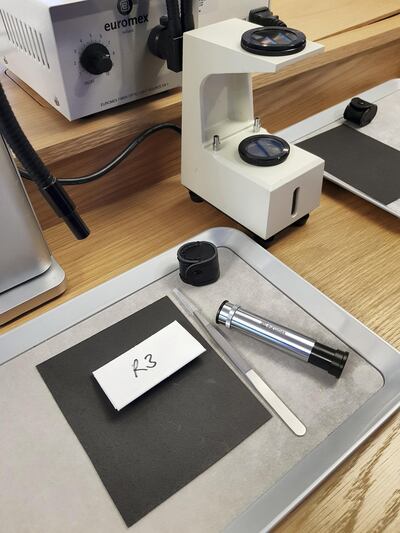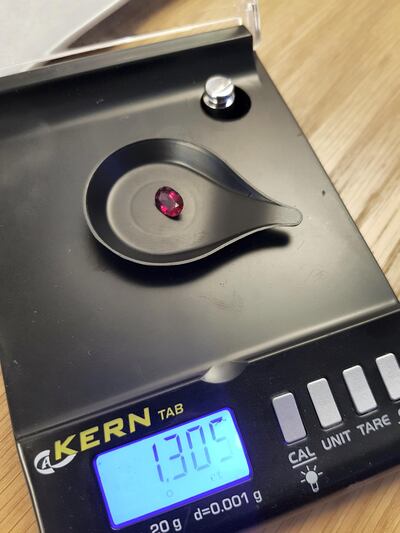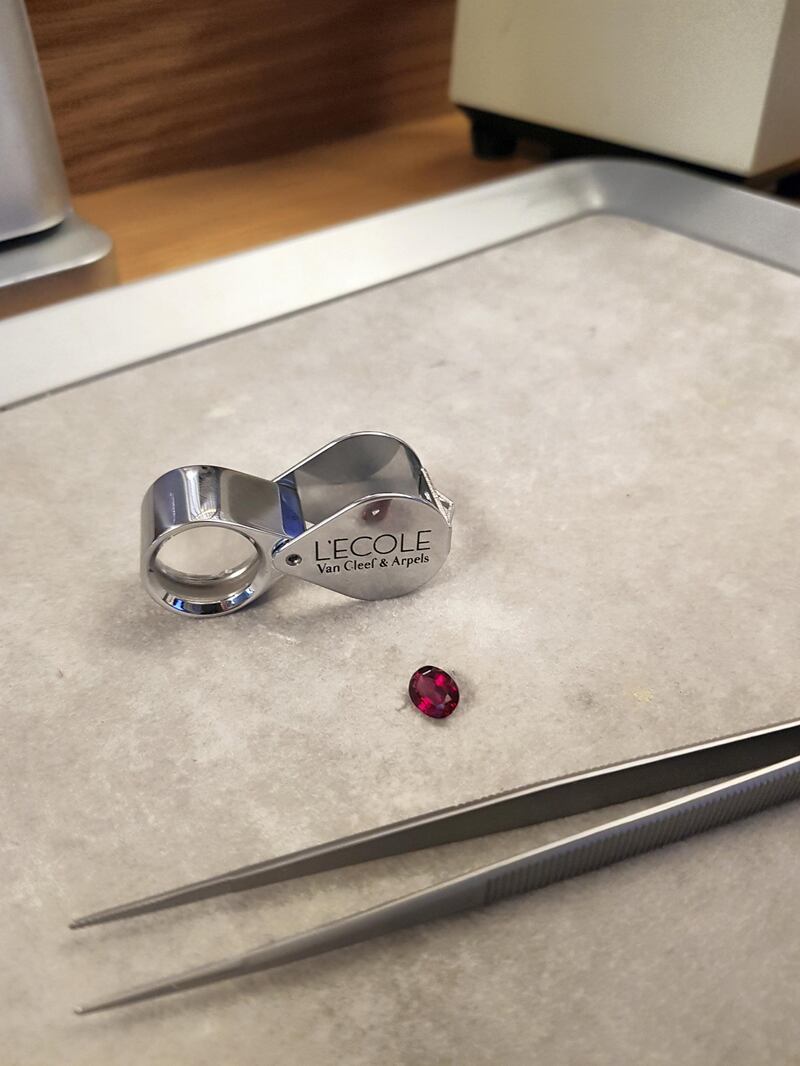I find myself clutching a ruby the size of my fingernail, quite gingerly as you can imagine, between a pair of tweezers. My task is to examine this and three other stones under different light sources, including one that mimics the middle of the afternoon on a European winter's day – how's that for specific? The aim is to find telltale marks, cracks or internal flaws, known as inclusions.
I am at L'Ecole Van Cleef & Arpels in Dubai Design District. After holding a series of workshops last year, the storied jewellery house has brought its nomadic school to Dubai for a second time, and until Saturday, it will host classes, exhibitions and talks conducted by gemmologists, jewellery designers and historians.
The Recognise the Gemstone class I am trying my hand at, for instance, is run by Dominique and Lilly. A former VCA buyer and gems dealer, Dominique has vast experience identifying stones, while Lilly, who has been with Van Cleef & Arpels for almost 40 years, has a level of expertise that's hard to match. The workshop is divided into three teams of four (classes are reassuringly small, at only 12 students), one each for rubies, sapphires and emeralds. As a part of the ruby team, I begin to peer at each of the four stones assigned to us to determine whether they are precious, synthetic, fine or artificial.
Precious stones refer to diamonds, emeralds, rubies and sapphires, while fine stones include more than 70 other types of gems, including garnets, tourmalines, malachite and onyx. I learn the term "semi-precious" is no longer used in the jewellery industry, as it is too vague. Synthetic stones, meanwhile, are chemically identical with natural precious stones but are made in a lab, while the term artificial refers to counterfeit items, such as a chunks of glass passed off as emeralds.
The grading of precious stones is a delicate art, and value is attributed on a stone-by-stone basis, even among a group of gems excavated from the same mine. Having been created under immense heat and pressure deep in the belly of our planet, each stone is unique, so much so that a flawed Burmese ruby could well be more valuable than an almost flawless diamond. Clearly, knowledge is key in this world.

Let loose on bewildering equipment with improbable names (hello, spectroscope, gravity scale and polariscope), we examine the stones, consult wall charts and pore over handbooks to compare notes. Despite being small, each piece of equipment is specialised, helping to eliminate what the stone isn't, to help arrive at what it is.
Irrespective of type, colour or value, gemstones are all crystals and, as such, are a regular combination of atoms. Those atoms may align into differently shaped structures, such as a cube or hexagon, but that shape will always be symmetrical, and will always be governed by certain criteria. For example, under this crystalline system, diamonds are classified as cubic (isotropic), meaning light travels through the stones almost in a straight line. By contrast, a ruby is non-cubic (anisotropic) and, similar to a prism, light shone on it will scatter in different directions, causing internal refraction of two colours.
How does this help the gem buyer? Say you're examining a stone offered as a white (clear) diamond. If a peek though a nifty little eyeglass – a dichroscope – reveals two colours, you know that, while this clearly isn't a red ruby, it definitely isn't a diamond, either.
However, before we all declare ourselves gemstone experts, correct identification is obviously lot more complicated than that. Normally, an aspiring gemmologist will spend from two to six months completing a course such as this, so at four hours, my education is hardly exhaustive. The machines also give subtle readings that are easy to misread, while those telltale shifts in light and tone are so nuanced as to be almost imperceptible to the untrained eye.

Dominque is quick to suggest that those interested in the subject should visit a gemstone market, to absorb first-hand the noise and atmosphere of countless gems changing hands. Tellingly, he is even quicker to tell us not to buy a serious stone at such a market unattended because, he explains, professional dealers will have picked up the best pieces already.
We would therefore be prey to unscrupulous sellers, eager to exploit our inexperience at top-dollar rates. He suggests we "spend what you would on a souvenir, as this is what you will end up with".

Back at D3, after four rather breathless hours, every student is asked to name the stone they were entrusted with. Astonishingly, everyone identifies their stones correctly. In the ruby group, we positively identified our stones as one rubellite (fine, in the tourmaline family), one spinel (also fine), one precious ruby, and one synthetic ruby.
Despite the matching machine readings for both rubies, in the end we distinguished the natural stone from the man-made one through good old-fashioned detective work. One of the rubies was filled with black flecks and areas that looked almost shattered, while the other was dazzlingly clear. As Dominque explains: "You have to learn to trust your instincts, which should be backed up by the readings. However, experience will tell you that is it very unusual to find a ruby with no inclusions. In this case, seeing a clear stone should immediately set off alarm bells."
While my career as a gemmologist may be some way off, this fascinating course is a must for anyone interested in gemstones, or even finding out why jewellery can be so expensive.






